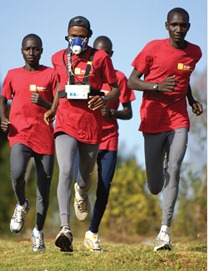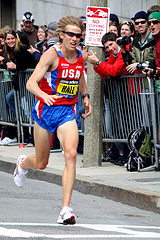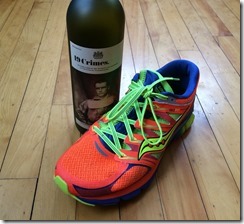 This afternoon I completed my first ever VO2max test. The test is something I’ve taught about in my Exercise Physiology class, but until today I’d never actually done one myself, so it was with a great deal of excitement that I drove the hour from my campus to the exercise physiology lab at the University of New Hampshire for my first visit as part of a barefoot vs. shod running economy study.
This afternoon I completed my first ever VO2max test. The test is something I’ve taught about in my Exercise Physiology class, but until today I’d never actually done one myself, so it was with a great deal of excitement that I drove the hour from my campus to the exercise physiology lab at the University of New Hampshire for my first visit as part of a barefoot vs. shod running economy study.
The study is being conducted by UNH Master’s student Corie Mae Callaluca and senior undergraduate Neil Baroody (they are looking for more participants – see bottom of post). Their goal is to compare economy between habitually barefoot (true barefoot, not minimalist) and shod runners, and to look at how economy changes if a shod runner is trained to run barefoot over a period of about 2 months (I’m in the shod group since my barefoot mileage is minimal, and not sure if I’ll do the barefoot training as I have two races coming up).
 The study involves several visits to the UNH lab, and on my visit today they took baseline anthropometric measurements (height, weight, skinfold caliper measurements for body fat, etc.), and I did a VO2max test on an instrumented h/p/cosmos treadmill (see image at left, that’s not me though :) – no force data were collected today). For the treadmill test, I did a 5 minute warmup run, then was outfitted with a portable Cosmed respiratory gas analyzer. This involved having a facemask strapped to my head, and a small analyzer unit attached via a harness to my chest – pretty cool system (see below right, again not me in the photo!).
The study involves several visits to the UNH lab, and on my visit today they took baseline anthropometric measurements (height, weight, skinfold caliper measurements for body fat, etc.), and I did a VO2max test on an instrumented h/p/cosmos treadmill (see image at left, that’s not me though :) – no force data were collected today). For the treadmill test, I did a 5 minute warmup run, then was outfitted with a portable Cosmed respiratory gas analyzer. This involved having a facemask strapped to my head, and a small analyzer unit attached via a harness to my chest – pretty cool system (see below right, again not me in the photo!).
When the test started I ran for a bit at steady pace, then they increased the incline at one minute intervals while keeping the pace steady. At each incline increase I had to report my rate of perceived exertion, and all the while my respiratory gasses and heart rate were being recorded.
Initially I felt very comfortable with the mask on, but as the incline went up and my respiratory rate increased the mask started to make me feel a bit claustrophobic – felt as if I couldn’t get enough air through it. The hardest part was actually the fact that the mask made it hard for me to see the treadmill belt, which is a bit unnerving when you are maxing out. It’s amazing how quickly things got hard, and I made it 7-8 incline increases before I cut myself off – I was sucking hard through the mask and my heart was racing.
Once they stopped the treadmill I hopped off and tried to rip off the mask so I could get some air – don’t think I was supposed to do that! I took a few minutes to recover and got a printout of my data – my VO2max came out at 50.5 ml oxygen/min/Kg. Not particularly special, but not bad either. One thing that didn’t register for me until today is that VO2max is dependent on the body weight you record prior to the test (i.e., the Kg part of the ml O2/min/Kg), so small fluctuations in weight can slightly alter your specific VO2max value. I figure if I drop another 30 pounds of body fat so that I look the part of an elite marathoner my VO2 max will be something to talk about!
The next step is for me to return next week and run a 5K time trial on an indoor track with the gas analyzer mask attached – that ought to be interesting and rather difficult to say the least! I also get to run on the treadmill again and have force measurements taken, which I’m really looking forward to.
That’s the description of the test itself, so what exactly does VO2max mean? Basically, it’s a measure of how much oxygen you can deliver to your working muscles during maximal exercise. The higher your VO2max, the more oxygen you are able to deliver to fuel metabolism. This is influenced by many factors, from your lung size to your cardiac output to the capillarization of your muscles to the function of enzymes in your muscles. However, despite how often VO2max is mentioned, it’s not a perfect indicator of performance capability (other factors like economy and anaerobic threshold come into play here), but it can give some idea of your endurance potential (to view a list of some of the athletes with the highest recorded VO2max values, click here).
In addition to VO2max, my data spreadsheet contained a lot of additional information, including heart rate (looks like my max HR was 178bpm), and respiratory exchange ratio (RER). The latter is the ratio of carbon dioxide exhaled to oxygen inhaled and is an indicator the type of fuel the body is burning during exercise. Lower values (< 1) indicate greater fat burning, whereas values above 1 indicate greater use of carbs as fuel.
One last thing, the duo running this study are looking for additional participants. In particular, habitually barefoot runners, and shod females between 18-25 years old who can run a sub 22:00 5K are needed (the latter are what they need the most right now). If you are interested, contact Neil Baroody, or Corie May Callaluca – if you participate you get to do the VO2max test as well.
Finally, since I like numbers, I’ve included my raw data for a few variables below so you can see what it looks like. I’ve included values for time, V02 consumed/Kg, heart rate, and respiratory exchange ratio (R). Not sure what happened at 6:40-7:40 as everything dipped downward.
| Time | VO2 | Heart | RER |
| (ml/min/Kg) | Rate | VCO2/VO2 | |
| 0:20 | 5.24 | 57 | 0.78 |
| 0:40 | 5.01 | 66 | 0.77 |
| 1:00 | 6.23 | 76 | 0.8 |
| 1:20 | 11.52 | 92 | 0.81 |
| 1:40 | 22.32 | 120 | 0.74 |
| 2:00 | 36.01 | 134 | 0.72 |
| 2:20 | 39.28 | 139 | 0.82 |
| 2:40 | 38.32 | 141 | 0.87 |
| 3:00 | 37.01 | 142 | 0.9 |
| 3:20 | 36.65 | 142 | 0.93 |
| 3:40 | 37.41 | 142 | 0.93 |
| 4:00 | 37.42 | 144 | 0.94 |
| 4:20 | 37.46 | 143 | 0.93 |
| 4:40 | 39.06 | 142 | 0.93 |
| 5:00 | 36.79 | 142 | 0.94 |
| 5:20 | 37.68 | 142 | 0.9 |
| 5:40 | 37.69 | 142 | 0.92 |
| 6:00 | 38.82 | 142 | 0.93 |
| 6:20 | 28.16 | 136 | 0.94 |
| 6:40 | 20.29 | 118 | 0.95 |
| 7:00 | 14.65 | 108 | 0.99 |
| 7:20 | 16.52 | 105 | 1.01 |
| 7:40 | 23.66 | 118 | 1 |
| 8:00 | 31.23 | 132 | 0.9 |
| 8:20 | 35.96 | 140 | 0.89 |
| 8:40 | 35.29 | 141 | 0.91 |
| 9:00 | 37.17 | 139 | 0.92 |
| 9:20 | 38.85 | 144 | 0.93 |
| 9:40 | 40.2 | 147 | 0.92 |
| 10:00 | 40.47 | 148 | 0.94 |
| 10:20 | 41.42 | 151 | 0.95 |
| 10:40 | 42.35 | 152 | 0.95 |
| 11:00 | 43.35 | 158 | 0.97 |
| 11:20 | 44.04 | 161 | 0.99 |
| 11:40 | 45.46 | 164 | 0.99 |
| 12:00 | 47.95 | 165 | 1.01 |
| 12:20 | 48.62 | 168 | 1.05 |
| 12:40 | 48.25 | 169 | 1.06 |
| 13:00 | 50 | 169 | 1.09 |
| 13:20 | 50.52 | 171 | 1.13 |
| 13:40 | 48.75 | 173 | 1.16 |
| 14:00 | 49.59 | 174 | 1.17 |
| 14:20 | 49.79 | 176 | 1.25 |
| 14:40 | 47.61 | 178 | 1.3 |
| 15:00 | 44.74 | 178 | 1.29 |




















My buddy and I did a couple about 10 yrs ago when we were in around 34 min 10k shape. Mine was 65 and his was 55. He had a 31min 10k PR a few years prior. Interesting relationship between VO2 and economy. He must have been more efficient than me obviously.
Efficiency is definitely king in distance running. The rest are just minor variables.
looking for male participants anytime soon >.>
Hi Pete, Well done on the 5k result BTW ;-)
I am curious about the how the VO2Max results in the lab compare to the VO2Max estimates one can get from race performance – so I plugged your 18:53 5k time into the online calculator (based on Daniels formulas I believe) at link to brianmac.co.uk… and got 53.26, which is higher than your 50.5 in the lab.
Might this suggest a better running economy than the Daniels formula assume? Or perhaps the lab test just didn’t get the most out of you.
I am also curious why the VO2Max peaks at HR of 171 and then tails off as your HR goes higher, is this normal for this type of test? Does this suggest your breathing/muscle activation had maxed out but your HR still had some reserve left to go?
I also wonder if training in the with the gear on and at such high intensity would change ones response when doing the VO2Max test, not from getting fitter but just used to doing the test so getting better at it.
Robert,
It’s interesting – when I returned the next week and ran the 5k on the indoor track with the mask on my VO2 intake went higher than my V02max recorded the previous week, and was closer to that predicted by the Daniels formula. Maybe the mask wasn’t fitted well when I did the treadmill test. As for what happened to the VO2 at the end, probably because I tried to rip the mask of because I was gasping :)
Pete
Can we ask what pace you maintained throughout the test? I’d like to try this at home — without all the fancy gear!
I don’t even know, I think something between 7:30-8:00/mile maybe
I did a Max Vo2 test on a bike a few years ago – it is so freaking hard. I just about blacked out afterwords, and the skinny little freak who did the test told me “you did a good test.” 62.8 vo2 max @ 192 lbs….
Some research like this has already been done and published at ACSM. Check the 2012 abstracts. Be interesting to compare results
There’s the whole interval between 6:00 and 9:00 where the heart rate and RER aren’t making much sense.
Maffetone talks about the RER vs heart rate curve, with emphasis on finding out where the inflection point lies along it (the point where the slope changes abruptly). He argues that this is the effort level at which to do base training. For you, it looks like it’s about 135-140 bpm, reasonably close to the simple 180-age formula he came up with. Although he does recommend a longer warm up than you were given and (I’d imagine) a slower build up too. I’ve been doing Maffetone in the off season and Jack Daniels in the racing season.
I tend to do similar, Daniels when training in season, easy in off season, though I don’t tend to pull out my HRM as much as I should.
I did a VO2Max test on my bike this spring, and that claustrophobic feeling of restriction was quite traumatic. I was sweating buckets and couldn’t get a sip of water, to the point where I was inhaling sweat-fumes that dripped down my lips.
I have my doubts regarding the applicability of the results – I aborted at 178bpm, whereas I regularly see 195bpm in hard sessions – because I wasn’t limited by lactate, exhaustion or even breathing.
Pete, I was wondering if you will apply the test results to your training? Is this just interesting data or will you modify your running paces based on the test results?
No, probably won’t much affect my training, especially since in my follow up visit I exceeded my supposed VO2max during a 19:35 5k on an indoor track…
—-
Pete Larson’s Web Links:
My book: Tread Lightly – link to ow.ly
Blog: https://runblogger.com
Twitter: link to twitter.com
Facebook: link to facebook.com…